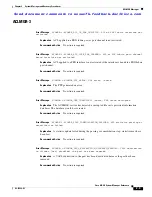
S e n d d o c u m e n t c o m m e n t s t o n e x u s 7 k - f e e d b a c k - d o c @ c i s c o . c o m
1-5
Cisco NX-OS System Messages Reference
OL-15994-03
Chapter 1 Introduction to System Messages
Capturing System Messages and History
%AUTHPRIV-3-SYSTEM_MSG: AUTHPRIV [dec] reported a failure in service [chars]
This example shows the following:
•
Facility code is AUTHPRIV (indicating that it is a authpriv-specific error).
•
Severity is 3 (notification).
•
Alarm or event code is SYSTEM_MSG.
•
Description of the problem is Authpriv
[dec] reported a failure in service [chars]
.
•
[dec] is the module slot number associated with this message.
•
[chars] is the service name that experienced this failure.
Capturing System Messages and History
The system messages are displayed instantly on the console, by default, or are redirected to an internal
log file, or a syslog server. System message severity levels correspond to the keywords assigned by the
logging
global configuration commands. These keywords define where and at what level these messages
appear. Only system messages that correspond to the configured logging level or higher severity
messages are logged. As an example, if you set the logging level to 3 (error), then you get error, critical,
alerts, and emergency system messages, but you do not get warning, notification, informational, or
debugging system messages.
For complete information about handling system messages, see the
Cisco Nexus 7000 Series NX-OS
System Management Configuration Guide, Release 4.1
.
Saving the System Messages Log
The
logging logfile
global configuration command enables copying of system messages to an internal
log file and optionally sets the size of the file. To display the messages that are logged in the file, use the
show logging
EXEC command. The first message displayed is the oldest message in the buffer. To clear
the current contents of the buffer, use the
clear debug-logfile
command.
Logging System Messages to a syslog Server
The
logging
host-name
command identifies a syslog server host to receive logging messages. The
host-name
argument is the name or Internet address of the host. By using this command more than once,
you build a list of syslog servers that receive logging messages. The
no logging
host-name
command
deletes the syslog server with the specified address from the list of syslog servers.
Displaying Information about System Errors
System errors may be generated by processes running on the device. System errors have an ID that ranges
from 0x0 to 0xffffffff. You can use the
show system error-id
command to display the facility and
description of a system error. To get a list of descriptions for all error IDs, use the
show system error-id
list
command.
The following example displays information about the specified error ID.
switch#
show system error-id 0x401D0019
















































